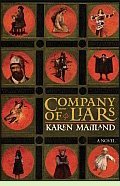|
Company of Liarsby Karen MaitlandReviewed by Margaret Donsbach The narrator and protagonist is a camelot, an itinerant seller of faked saints' relics, who prefers to travel alone. But in the sodden year of 1348, with plague breaking out in the port towns of southern England and spreading northward, a motley group of fellow travelers collects around this reluctantly kind-hearted narrator. As their journey progresses, it becomes evident that each of the nine travelers is attempting to escape not just the plague, but the truth about his or her past. But as the most mysterious of these travelers insists, the truth has a way of making itself known. The camelot's first encounter is with the child Narigorm, who "looked about twelve years old, barefoot and clad in a grubby white woollen shift, with a bloodred band about the neck that made the whiteness of her hair shimmer." She has an odd stare. "Was that the beginning?" the narrator wonders. "Was that what caused it all—half a pastry offered to a child with eyes of ice?" As the travelers collect and travel northward, the reader may wonder whether this is a straight historical novel or historical fantasy. The fourteenth century was steeped in superstition. As the author points out in a historical note at the end: "At that time it was considered heresy by the Church not to acknowledge the existence of vampires and werewolves." If anything, the travelers are unusually rational and skeptical for their time. Only Narigorm's weird, unchildlike skill with runestones clearly shifts Company of Liars into the realm of spooky fantasy. (2008, 465 pages) More about Company of Liars from Powell's Books
The Plague Tales by Ann Benson (1997), about an archaeologist in the near future who inadvertently starts a new plague epidemic and a medieval Jewish physician linked to the outbreak. Year of Wonders by Geraldine Brooks (2001), a literary novel about a woman in an English village that makes the altruistic decision to close itself off from the rest of the world when it experiences a plague outbreak. World Without End by Ken Follett (2007), a sequel to Pillars of the Earth which can be read as a stand-alone novel; set in fourteenth century England. Review The First Vial by Linnea Heinrichs (2005), about a fourteenth century noblewoman struggling to keep her castle and land during a plague epidemic. Katherine by Anya Seton (1954), about Katherine Swynford, the mistress of John of Gaunt and ancestress of the Plantagenet kings of England. Doomsday Book by Connie Willis (1992), a novel about a woman of the future who time-travels to plague-stricken England in the fourteenth century.
In the Wake of the Plague: The Black Death and the World it Made by Norman Cantor (2001) The Great Mortality: An Intimate History of the Black Death, the Most Devastating Plague of All Time by John Kelly (2005) The Great Plague: The Story of London's Most Deadly Year by A. Lloyd and Dorothy C. Moote (2004)
Information on the Black Death in the Middle Ages from BoiseState.edu
Back to Medieval: 14th and 15th Centuries
|
 Though Company of Liars is being billed as a "reinterpretation of Chaucer's Canterbury Tales," the comparison may do it a disservice. Unlike Canterbury Tales, essentially a collection of short stories in a sketchy frame describing the pilgrims who tell them, Maitland's novel focuses primarily on the travelers themselves. The few, brief and well-told stories in Company of Liars are relevant to the central plot, which builds to a creepy, suspenseful climax.
Though Company of Liars is being billed as a "reinterpretation of Chaucer's Canterbury Tales," the comparison may do it a disservice. Unlike Canterbury Tales, essentially a collection of short stories in a sketchy frame describing the pilgrims who tell them, Maitland's novel focuses primarily on the travelers themselves. The few, brief and well-told stories in Company of Liars are relevant to the central plot, which builds to a creepy, suspenseful climax.